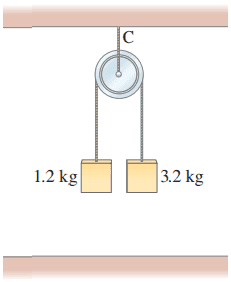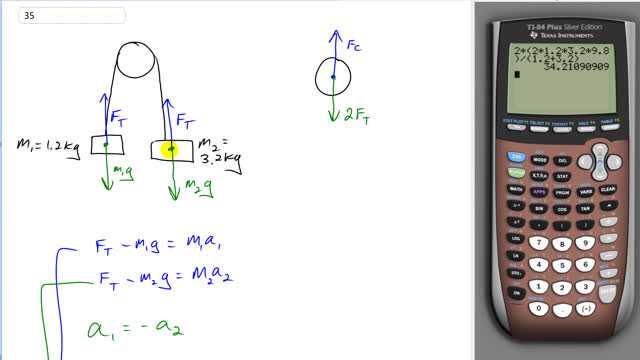
Suppose the pulley in Fig. 4–55 is suspended by a cord C. Determine the tension in this cord after the masses are released and before one hits the ground. Ignore the mass of the pulley and cords.


In order to watch this solution you need to have a subscription.
This is Giancoli Answers with Mr. Dychko. This picture on the left shows the forces on each of the blocks and the block experiences a tension force upwards and that tension is constant along the rope, and so, the right hand block experiences the same tension force up and they experience different forces of gravity downwards depending on their masses. Now, the pulley experiences two tension forces downwards, one on each side. On this edge there's a single tension force pulling down. And because the rope is not slipping. And likewise on this edge there's a tension force pulling down on the pulley because this arrow here shows the tension force upwards on the block. And the Newton's third law counterpart to this force is the force applied on the rope due to the block, and that eventually is really applied up here on the pulley as well. So, there's the picture for the pulley, two times the tension force down and then the force of the cable connecting it to the ceiling upwards, and this is ultimately what we have to find. But in order to do that we need to determine the tension force. And so, I've written down Newton's second law for each of the blocks. Block one has tension force up minus m1g downwards, the gravity down. And that equals the mass times its acceleration. And for the second block it's the same tension force up minus m2g equals m2a2. These have different accelerations sort of, the same magnitudes but they're opposite directions because they're all part of the same system, the rate at which they accelerate will be the same but one will go up and the other one will go down. So, one is the negative of the other. So, let's rewrite this Newton's second law for the first block. Substituting with negative a2 in place of a1, otherwise it's a copy. Copied this part here. And then we'll solve that for a2 and then make a substitution into the second equation. So, we'll move this a2 to the right hand side, or sorry, left hand side. And... I'm sorry. Yeah, well. And I also multiply everything by negative 1. It's nice to have this unknown on the left, making it positive is sort of what I'm doing here. So, multiply everything by negative 1. So, the sign of everything changed. And then flip the sides around. So, the m1gis positive and the FT is negative and then this thing is positive. Sign of everything changed and put the m on the left and then divide by m1 so, acceleration 2 is m1g minus force tension divided by m1. And that is what we'll substitute into this expression. And instead of a2 will now write all of this. So, it's FT minus m2g, just copied, equals m2, also copied, times this substitution for a2. And we'll multiply everything by m1 to get rid of this denominator. So, that's FT times m1 minus m1m2g equals m1m2g minus m2FT. So, the m1 cancelled on the right hand side but th+en I also distributed the m2 into the brackets. And then move this to the left, makes it positive FTm2. And move this to the right and it's the same term, they're like terms, so, that's 2m1m2g. And then the next line, factor out the common factor FT. So, it's Ft times m1 plus m2 equals 2m1m2g. And the tension force then is when you divide by this bracket here. The tension force is 2 times m1m2g divided by m1 plus m2. And so, the force on the cable connecting the pulley to the ceiling has two times that tension force. So, it's 2 times 1.2 kilograms times 3.2 to kilograms times 9.8 Newtons per kilogram. all divided by the sum of the masses, and that gives 34 Newtons.